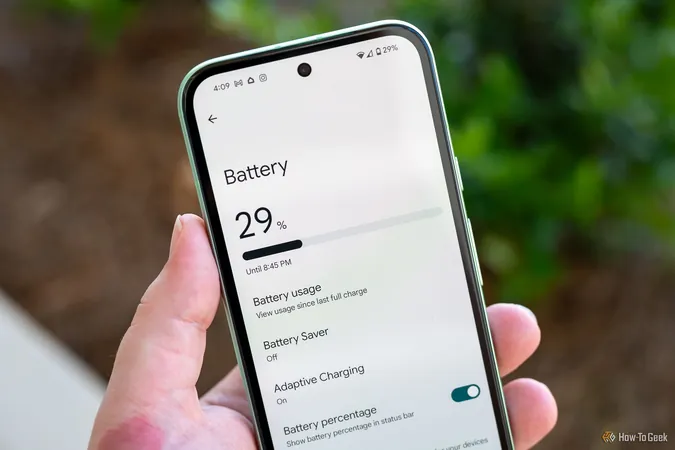
Android 16 Introduces Battery Health Monitoring for Pixels—But Not Everyone Can Use It!
2025-03-30
Author: Sarah
Android 16 Introduces Battery Health Monitoring for Pixels—But Not Everyone Can Use It!
Have you ever been baffled by the sudden decline in your smartphone's battery life? One moment, your phone feels as though it can go on forever; the next, it's running low on juice well before dinner. If this sounds familiar, you're certainly not alone in your frustration. Until recently, Google’s Android operating system lacked a straightforward method for users to monitor their phone's battery health.
Now, with the introduction of Android 16, Google is rolling out a significant enhancement: a Battery Health feature available in the latest beta versions. This new tool allows some Pixel users to investigate the longevity of their device’s battery—offering valuable insights into its remaining life. However, there's a catch—all Pixel devices are not yet included, leading to questions about Google's strategy in promoting long-term smartphone usage.
How to Access Your Battery Health Data
To tap into this new feature, make sure you’re using Android 16 Beta 3 and have a compatible Pixel device. Here's how to check your battery health: 1. Open the **Settings** app on your Pixel. 2. Navigate down to **Battery**. 3. Click on **Battery Health** to see your battery’s current capacity and optimization tips.
In this section, users will discover: - The battery's health percentage, which indicates how much of its original capacity remains compared to a new battery. - Recommendations to extend the battery’s lifespan based on personal usage habits. - Quick settings to enable features such as Adaptive Charging or limiting charging to 80%.
For years, iPhone users have enjoyed similar functionality through Apple’s built-in Battery Health tracker since iOS 11.3. Until now, Android users had to rely on third-party applications like AccuBattery, which often falls short of providing accurate readings.
This new feature marks a significant leap forward for Android, addressing a long-standing gap.
But There’s a Catch!
Here’s where things get a bit frustrating: the Battery Health feature isn’t available for all Pixel models. Currently, it’s exclusively functional on the Pixel 9 series and surprisingly the Pixel 8a.
If you own a Pixel 8, Pixel 8 Pro, Pixel 7, or older, you might see the Battery Health option, but tapping into it reveals only generic battery care tips without any actual health metrics.
This disparity raises a crucial question: why does a more budget-friendly device like the Pixel 8a have access to this feature while its more expensive counterparts do not?
While Google hasn’t provided a clear explanation, it’s likely that the Pixel 8 and 8 Pro may have different battery management systems or firmware that Google is still developing support for. As Android betas are released progressively, it’s common for features to be tested on select devices before wider rollout.
Although it’s understandably frustrating for users of unsupported models, chances are high that expanded access will arrive when Android 16 moves out of beta.
The Importance of Battery Health Monitoring
Consider this: if your phone originally came with a 5,000 mAh battery, but after a couple of years, its health has declined to 80%, you’re only benefiting from about 4,000 mAh. This reduced capacity could easily explain why your device drains faster, overheats, or seems less reliable.
With the Battery Health feature, you gain actionable insights rather than relying on guesswork. It helps you make informed decisions regarding battery replacements, charging habits, or simply understanding performance declines.
Smart tips to optimize your battery health include: - Activating the 80% charge limit feature to reduce wear. - Utilizing Adaptive Charging for gentle overnight top-ups. - Steering clear of fast charging when unnecessary, particularly when your phone is warm.
Greater visibility into your battery’s health is crucial—especially if you plan to keep your device for the long haul.
A Shift in Google’s Approach to Smartphone Longevity
The introduction of a built-in Battery Health feature, even if currently limited, signals a significant shift in Google's focus: they understand that consumers are keeping their phones longer.
Both Pixel 8 and 9 devices come with a promise of seven years of Android updates. But extended support is only viable if the hardware remains capable, starting with the battery itself. By providing users with transparent monitoring, Google makes a savvy, user-centered move that reflects an evolving understanding of customer needs.
Stay tuned as Android 16 continues to roll out and potentially transforms how we interact with our devices!
 Brasil (PT)
Brasil (PT)
 Canada (EN)
Canada (EN)
 Chile (ES)
Chile (ES)
 Česko (CS)
Česko (CS)
 대한민국 (KO)
대한민국 (KO)
 España (ES)
España (ES)
 France (FR)
France (FR)
 Hong Kong (EN)
Hong Kong (EN)
 Italia (IT)
Italia (IT)
 日本 (JA)
日本 (JA)
 Magyarország (HU)
Magyarország (HU)
 Norge (NO)
Norge (NO)
 Polska (PL)
Polska (PL)
 Schweiz (DE)
Schweiz (DE)
 Singapore (EN)
Singapore (EN)
 Sverige (SV)
Sverige (SV)
 Suomi (FI)
Suomi (FI)
 Türkiye (TR)
Türkiye (TR)
 الإمارات العربية المتحدة (AR)
الإمارات العربية المتحدة (AR)